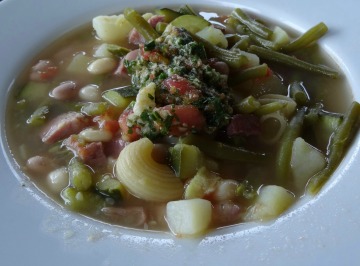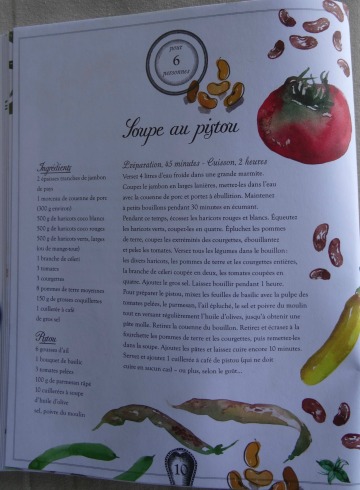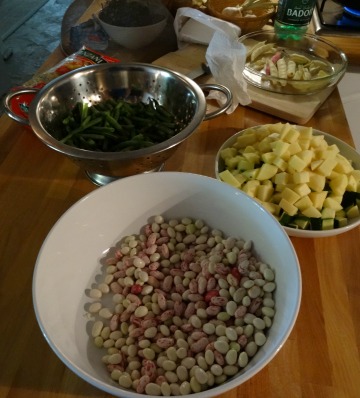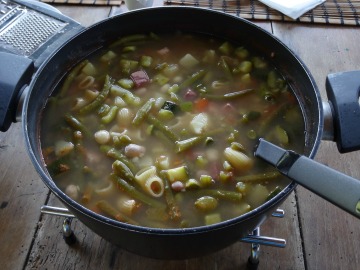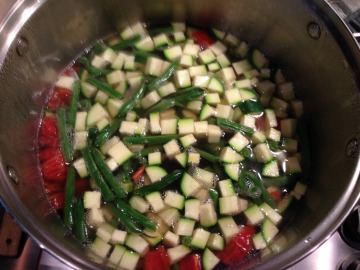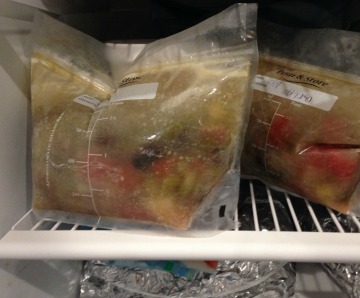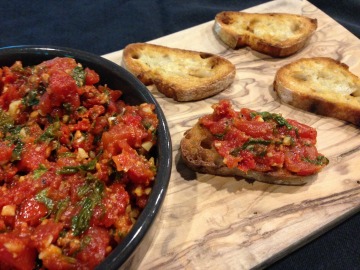
Filet Mignon Diable
Long before I started this blog and began to write personal essays about food and recipes, I came to understand that food was the way into my stories. Others might use gardening or travel or any number of subjects as their point of entry, but for me, it has always been food.
Call it the Proustian effect, or the madeleine effect—I’m not sure what the nomenclature is exactly—but it is the link between food and memories that is well documented and actually has a scientific basis in fact. (Should you care to get all wonky about it, I came across the scientific explanation in a book review I wrote last year. If memory (wink-wink) serves me correctly our food memories are stored in a primitive part of our brain so there is no real mystery as to why food and stories go together.)
Memory has been weighing heavily on me of late. For one, my French writers class has been reading Pour que tu ne te perdes pas dans le quartier (So that You Don’t Get Lost in the Neighborhood) by the Nobel prize-winning author, Patrick Modiano. Memory is a perennial theme in his novels. In an interview he gave at the time he won the Nobel for literature in 2014, he likened the slow building of the narrative in his novels to the way photographs used to be developed in a bath of chemicals, bringing the image into focus over time. Memory operates much the same way; what at first seems fuzzy gradually becomes more clear.
Just by coincidence, at the same time I have been reading Modiano, I have been working on a project to digitize all my old photos that have been stored in albums and boxes collecting dust. I have carried these photos with me over the years from one home to the next without thinking much about them. But now my husband and I have made the decision to move back to an urban setting in an apartment with half the space of our sprawling suburban home and I am determined to pare down.
Sitting at my desk scanning old photos is both tedious and emotional. It is a reckoning with one’s past that comes into focus little by little, like a Modiano novel.
Of course, a large portion of my trove of photos are of family. Many of them are of my sister’s children when they were at their most adorable, photogenic selves back in the 1990s. Back then, I was the single aunt whose attention was focused (there’s that word again) solely on them whenever I came to visit. For most of their childhood they knew me only as an unmarried woman. As I have pored over these photos of our times together I see more clearly now how jarring it must have been for them to suddenly have to make room for a man who appeared out of nowhere and had become the primary relationship in my life.
At the time, it felt hurtful that my niece and nephew (by then, adolescents) were unwelcoming, but now, looking at all those photos from their childhood I see that I was someone as special to them as they were to me. Suddenly they had been replaced (or they felt they had been replaced). None of us had the tools or the perspective to process any of this in the moment and, sadly, there was plenty of ill-will that resulted that has never been fully resolved.
But because I use food as a way into my stories, I got to thinking about food memories I might have shared with them. I have been racking my brain trying to come up with something to accompany all those photos from family vacations with my parents on Cape Cod to the numerous Christmases we spent together, and I have come up completely short. To me, that is astonishing.
I know that I cooked for them. I cook for everyone in my family (and now my husband’s family). Cooking is both recreational and an act of love for me. My sister, on the other hand, finds cooking a chore. She cooked in order to feed her family, but she had no interest in it beyond expediency. With that in mind, I know that when I visited I often brought recipes with me to relieve her of what she considered a chore and what I considered an opportunity to flex my culinary muscles.
And yet, I don’t recall a single meal I cooked for them. What I do remember is that my brother-in-law sent a message to me via my sister that I was not to cook anything with “voulez-vous sauce”.
My brother-in-law and I disliked each other from the start. Our mutual contempt vibrated just below the surface—or maybe it was always just above the surface, like an aura. We were the only two who were fooled by our efforts to conceal it.
In any case, mealtime at my sister’s house, was usually an exercise in power dynamics. It’s possible that by cooking I was trying to assert my dominance. But I have never used food as a weapon. It means too much to me. So, when my brother-in-law instructed my sister to tell me no “voulez-vous sauce”, it was clear to me he was trying to take control in the kitchen, while at the same time demeaning my interest in French food—and hence, me.
Maybe I stopped cooking for them altogether. Or maybe I have just buried those memories so deep they are forever gone, but for the life of me I can’t remember anything I made for them.
I do remember one final Christmas I spent at my sister’s house when my niece and nephew were in early adolescence. My parents were there too and I’m sure my mother must have made her famous sour cream mashed potatoes. I made something too, but I don’t recall what it was. What I do recall is that both my niece and nephew objected to it with such ferocity that it stopped the meal. What on earth I could have prepared that elicited that kind of full-throated reaction I don’t know, but it was breathtaking in its cruelty.
For a cook, to have anyone raise their voice in anger over what you have prepared feels like being kicked to the curb. No wonder I don’t remember what it was.
That night, as the yelling and screaming continued at one end of the house, my parents and I sat quietly in the living room talking about how stressful it was to be in my sister’s home. The fabric of her family that was merely frayed a few years ago seemed to be unraveling. It might have been that night, or maybe it was a few months later, but I made the decision not to go back again the next Christmas. Being alone during the holidays actually seemed preferable to being caught in the crossfire of my sister’s family drama.
Of course, that was not the last time I saw them. Over the years we have had our ups and downs (mostly downs I’m sorry to say). The children grew up and brought a certain measure of heartache to each of us but none more so than to their parents. My sister and brother-in-law suffered mightily. My nephew—who is now six years into recovery—was incarcerated for a nonviolent drug offense and was expelled from university. As for my niece, well, she never got over my marriage. Her disdain for my husband is so great that we have had to sever our ties.
When I review all of the relationships I have had in my life and can find a connection to food with each of them and am unable to find a single connection with my sister’s family it feels downright perplexing and painful. I am left wondering if I have fooled myself. Food is my connection to my family and friends. Without it, there is a gaping hole.
Last month, my sister sent a text to me asking about a recipe for Steak Diable that she planned to make for my brother-in-law on Valentine’s Day. I carefully wrote out the directions for the recipe, which I learned from Dorie Greenspan’s excellent cookbook, Around My French Table. I was nervous. It contained a “voulez-vous sauce” and I didn’t really want to be associated with it. Still, my eagerness to share a recipe got the better of me, and channeling my inner Julia Child, I gave her my most explicit directions.
The next day, she called me instead of texting. “I just wanted to call and tell you over the phone how perfectly your recipe turned out,” she exclaimed. I was flabbergasted. “But there was ‘voulez-vous sauce’,” I said. “Yes, but I put it on the side and when he tasted it he said, ‘This is the best steak I have ever eaten.’ And then she said to me, “I told him, ‘My sister is a really good cook.’”
My heart swelled.
Filet Mignon Diable
(Adapted from Around My French Table by Dorie Greenspan)
Serves 4
Ingredients:
4 filets mignon (1 ½ inches thick) at room temperature that have been pre-seasoned with salt and pepper.
1 Tablespoon unsalted butter
1 Tbsp olive oil
For the Sauce:
1 medium shallot, finely diced
1 garlic clove, finely chopped
1/3 cup dry white wine
2 Tablespoons cognac or other brandy
1/3 cup heavy cream
3 Tablespoons Dijon mustard
1-2 teaspoons Worcestershire sauce
Directions:
Pre-heat oven to 425°.
Pre-heat a cast iron skillet on the stove on medium high until it is very hot (3-5 minutes). Melt the butter and oil in the skillet and place seasoned steak in the pan. Sear the steaks on each side for 4 minutes and then slide the skillet into a hot oven for another 5 minutes, or until the internal temperature has reached 125° for medium rare. When the steaks are done to your liking, transfer them from the pan to a plate and tent them while you prepare the sauce.
Sauté the shallots and garlic in the remaining fat in the skillet over medium low until they are soft but not browned. Add the wine and Cognac and let boil for a minute while you scrape up the bits at the bottom of the pan. Then add the cream, mustard and Worcestershire sauce and taste for seasoning. Add any accumulated juices from the beef that has been resting to the pan and when heated through, turn off the heat and spoon the sauce over individual steaks to serve.
Filet Mignon Diable Printable Version









































